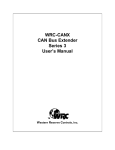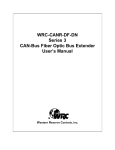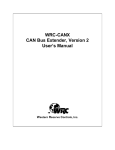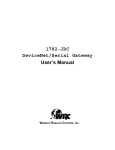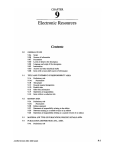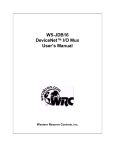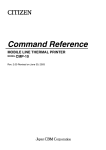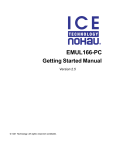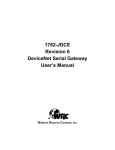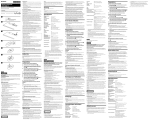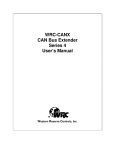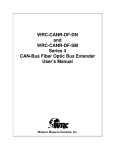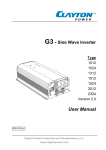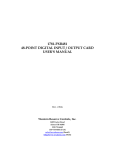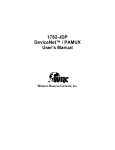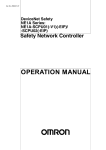Download 1782-JDA4 4-point DeviceNet Analog Input Block user`s manual
Transcript
1782-JDA4 SmartMux-Lite™ / DeviceNet™ User’s Manual Western Reserve Controls, Inc. Western Reserve Controls PUB 12.0 1782-JDA4 SmartMux-Lite User’s Manual Although every effort has been made to insure the accuracy of this document, all information is subject to change without notice. WRC takes no liability for any errors in this document or for direct, indirect, incidental or consequential damage resulting from the use of this manual. Document PUB 12.0 Rev 1.00 Sept 1997 Copyright © 1997 WRC Western Reserve Controls, Inc. 526 South Main Street, Suite 310 Akron OH 44311 330-762-1611 (Phone) 330-762-1622 (FAX) [email protected] (Email) http://www.wrcakron.com (Web) SmartMux, SmartMux-Lite and WRC are trademarks of Western Reserve Controls. DeviceNet is a trademark of the Open DeviceNet Vendor Association (“ODVA”). All other trademarks are property of their respective companies. Western Reserve Controls PUB 12.0 1782-JDA4 SmartMux-Lite User’s Manual TABLE OF CONTENTS 1. OVERVIEW ............................................................................................................................................................ 1 1.1. FEATURES ............................................................................................................................................................... 1 1.2. DEVICENET SYSTEM CONFIGURATION .................................................................................................................... 1 1.3. BASIC OPERATION .................................................................................................................................................. 2 1.3.1. Polled I/O ....................................................................................................................................................... 2 1.3.2. Cyclic I/O........................................................................................................................................................ 2 1.3.3. Bit-Strobe Message......................................................................................................................................... 2 2. USING THIS MANUAL......................................................................................................................................... 3 3. QUICK START....................................................................................................................................................... 4 4. GENERAL SPECIFICATIONS ............................................................................................................................ 5 5. HARDWARE INSTALLATION AND CONFIGURATION .............................................................................. 6 5.1. OVERVIEW .............................................................................................................................................................. 6 5.2. CONFIGURATION ..................................................................................................................................................... 7 5.3. LED OPERATION .................................................................................................................................................... 7 5.4. ANALOG I/O............................................................................................................................................................ 8 5.4.1. Field I/O Wiring ............................................................................................................................................. 9 5.5. POWER REQUIREMENTS .......................................................................................................................................... 9 5.6. NETWORK CONFIGURATION .................................................................................................................................. 10 5.6.1. Network Termination .................................................................................................................................... 10 5.6.2. DeviceNet Connection Wiring ...................................................................................................................... 11 6. DEVICENET PROFILE AND DEVICENET OBJECTS ................................................................................ 13 6.1. ANALOG INPUT POINT OBJECT - CLASS 0A HEX ...................................................................................................... 13 6.1.1. Analog Input Assembly Data Format ........................................................................................................... 13 6.1.2. Attributes and Services ................................................................................................................................. 14 6.2. ANALOG INPUT GROUP OBJECT - CLASS 20 HEX ..................................................................................................... 14 6.2.1. Analog Input Group Assembly Data Format................................................................................................ 15 6.2.2. Attributes and Services ................................................................................................................................. 15 6.3. ACKNOWLEDGE HANDLER OBJECT - CLASS 2B HEX ............................................................................................... 16 6.3.1. Attributes and Services ................................................................................................................................. 16 6.4. ASSEMBLY OBJECT ............................................................................................................................................... 17 6.5. I/O CONNECTION INSTANCES................................................................................................................................ 18 7. ACCESSORIES .................................................................................................................................................... 19 8. TROUBLESHOOTING ....................................................................................................................................... 20 i Western Reserve Controls PUB 12.0 1782-JDA4 SmartMux-Lite User’s Manual LIST OF TABLES TABLE 5-1 MODULE STATUS LED (LABELED MS) ...................................................................................................... 7 TABLE 5-2 NETWORK STATUS LED (LABELED NS)..................................................................................................... 8 TABLE 5-3 1781 SERIES ANALOG I/O MODULES ......................................................................................................... 8 TABLE 5-4 WRC7 SERIES ANALOG I/O MODULES ....................................................................................................... 8 TABLE 5-5 ANALOG INPUT I/O TERMINALS ................................................................................................................... 9 TABLE 5-6 JDA4 POWER REQUIREMENTS ................................................................................................................. 10 TABLE 5-7 NETWORK MAXIMUM LENGTHS ............................................................................................................... 10 TABLE 5-8 DEVICENET WIRING TERMINATION ......................................................................................................... 11 TABLE 5-9 DEVICENET CONDUCTOR SIZES ............................................................................................................... 12 TABLE 6-1 JDA4 DEVICE PROFILE ............................................................................................................................ 13 TABLE 6-2 JDA4 ANALOG INPUT ASSEMBLY DATA ATTRIBUTE FORMAT .................................................................. 13 TABLE 6-3 CLASS 0A HEX CLASS ATTRIBUTES............................................................................................................. 14 TABLE 6-4 CLASS 0A HEX INSTANCE ATTRIBUTES ....................................................................................................... 14 TABLE 6-5 ANALOG INPUT COMMON SERVICES ........................................................................................................ 14 TABLE 6-6 JDA4 ANALOG OBJECT ASSEMBLY INSTANCE DATA FORMAT (INSTANCE 1) .......................................... 15 TABLE 6-7 CLASS 20 HEX CLASS ATTRIBUTES ............................................................................................................. 15 TABLE 6-8 CLASS 20 HEX INSTANCE ATTRIBUTES ........................................................................................................ 16 TABLE 6-9 ANALOG INPUT GROUP COMMON SERVICES ............................................................................................ 16 TABLE 6-10 CLASS 2B HEX CLASS ATTRIBUTES ........................................................................................................... 17 TABLE 6-11 CLASS 2B HEX INSTANCE ATTRIBUTES ..................................................................................................... 17 TABLE 6-12 ACKNOWLEDGE HANDLER COMMON SERVICES ..................................................................................... 17 LIST OF FIGURES FIGURE 5-1 1782-JDA4 SMARTMUX-LITE .................................................................................................................. 6 FIGURE 5-2 DEVICENET CABLE CONNECTOR ............................................................................................................. 12 FIGURE 5-3 DEVICENET CABLE SPECIFICATIONS ........................................................................................................ 12 ii Western Reserve Controls PUB 12.0 1. 1782-JDA4 SmartMux-Lite User’s Manual Overview The 1782-JDA4 SmartMux-Lite is a remote industrial I/O device that multiplexes analog data acquisition and control signals in industrial or commercial applications. The 1782-JDA4 is DIN-mounted I/O multiplexers and supports serial communications on a DeviceNet link. The 1782-JDA4 multiplexes four (4) points of analog I/O through WRC’s 1781-7B Series or WRC7 Series analog single point I/O modules, which plug directly into the multiplexer assembly. The 1782-JDA4 (also referred to as “JDA4” or SmartMux-Lite) connect these analog I/O signals to a DeviceNet communications system. Each input channel may be any voltage range desired, based upon the module selected. The SmartMux-Lite multiplexer is designed as a Group 2 Only Server on the DeviceNet system and its I/O is read by and written to by another device on the link defined as a DeviceNet Master (Client). JDA4 supports the Predefined Master/Slave Explicit Message Connection, Polled I/O, Cyclic I/O and BitStrobe. The device address, data rate and other parameters are software-configurable and are changed from the default by a third-party configuration tool. There are no jumpers and switches for the user to set. Each JDA4 has 2 green/red LEDs - one for module status and one for network status. Section 5 of this document describes the installation of the JDA4 multiplexer. 1.1. Features The 1782-JDA4 has the following features: • 4 Analog Input Channels - 10-bit conversation • Uses Industry-Standard “7B” Modules • Wide Range of Analog Inputs Available - T/C, RTD, Strain Gage, 4-20 mA, etc. • Point-by-Point Mix-and-Match Analog Signals by Module Selection • Isolated Analog Input signals available - up to 1500 V • Polled, Cyclic and Bit-Strobe I/O • Software Configurable Parameters • DeviceNet compatible WRC also provides other SmartMux-Lite products for discrete and analog I/O signal conditioning and multiplexing on DeviceNet: the 1782-JDB4 and 1782-JDB8 for 4 and 8 discrete points, respectively, and the 1782-JDA8 for 8 channels of analog and discrete I/O. In addition, WRC also provides products to extend DeviceNet and other CAN-based networks. These are the WRC-CANEXT series of CAN bus repeaters. 1.2. DeviceNet System Configuration A DeviceNet network is a distributed I/O system that may contain many different products from several different vendors. Products may be configured uniformly, as clusters, or as distributed clusters. Up to 64 devices, including the master, may be attached to a single DeviceNet network. Any of these, except the master, may be a SmartMux-Lite. A typical system will include a master, such as a PLC or industrial PC, and multiple slave devices. 1 Western Reserve Controls PUB 12.0 1782-JDA4 SmartMux-Lite User’s Manual 1.3. Basic Operation The JDA4 operates as an analog input device on the DeviceNet network. It is a slave device which can be assigned (allocated) by the system implementer to one specific master. The analog input data is a 10-bit conversion of the isolated signals coming from the 1781-7B or WRC7 Series Analog I/O Modules. These 10 bits are reported as a 2-byte value, with a range of 0 to 1023 counts, full-scale. The DeviceNet Master can receive the analog data from the JDA4 via the several methods described in this section. 1.3.1. Polled I/O The master can explicitly poll (interrogate) the analog input data from the JDA4. The analog data is returned to the master in a Polled Response Message. 1.3.2. Cyclic I/O Cyclic I/O is the function by which a slave device sends all its input data to the master at a specific time period without the host explicitly requesting it. When the specified time interval elapses the entire input data (all four analog input channels) are transmitted to the master. The only user-defined configuration required is to set up the time interval. 1.3.3. Bit-Strobe Message A Bit-Strobe Message is a very fast method by which the master can send one bit to and receive up to 8 bytes of data response from each slave device on the network. The JDA4 supports the Bit-Strobe feature and returns its 4 channels of input data as a Bit-Strobe Response when the Master sends a BitStrobe Command. The JDA4 ignores the one bit sent to it in the command message. No user-defined configuration is required. 2 Western Reserve Controls PUB 12.0 2. 1782-JDA4 SmartMux-Lite User’s Manual Using This Manual This manual serves to help the user to understand the capabilities of the SmartMux-Lite product family, how to install and configure an I/O subsystem using these products, and how to generate the commands from the system host to read data from or write data to the SmartMux-Lite. Section 3 describes how to quickly connect your SmartMux-Lite and get it up and running on the DeviceNet link. Section 4 provides the technical specifications for the products described in this manual. Section 5 describes the installation of the hardware, including mounting, connection to other I/O subsystem components, power requirements and configuration of the operating parameters of the SmartMux-Lite. Section 6 describes the DeviceNet Profile and DeviceNet Object data for these products. Section 7 lists common accessories that are used with the JDA4. Section 8 provides some troubleshooting hints in the event your SmartMux-Lite or I/O system is not operating as anticipated. 3 Western Reserve Controls PUB 12.0 3. 1782-JDA4 SmartMux-Lite User’s Manual Quick Start To quickly and easily install your SmartMux-Lite in your DeviceNet system, follow the instructions below. For more details, see Section 5. To Install and DeviceNet Establish Communications 1. Remove the SmartMux-Lite from the box and connect your DeviceNet cable to the 5-pin plug (supplied) according to DeviceNet cable wiring specifications. 2. Make sure that the DeviceNet network is terminated properly. 3. Plug in your analog input modules. (Warning: Do not insert or remove the modules under power.) 4. Make sure that there is power on the DeviceNet network and plug the cable into the SmartMux-Lite. 5. The SmartMux-Lite will undergo its initialization sequence, flashing both LEDs. After approximately 5 seconds, the Module Status LED (labeled “MS”) will go on solid green and network LED will flash green. 6. The green Network Status LED (labeled “NS”) will go on solid once the Master recognizes the unit on the link and allocates the connection. 7. The SmartMux-Lite is now operating on the network. To Configure the Node Address and Baud Rate 1. You may change the device address and/or the baud rate, using your configuration tool or a command from the Master. (Defaults are 63 and 125k baud.) 2. If you change the device address, the SmartMux-Lite will reset and assume the address. 3. If you change the baud rate, the new baud rate will not become effective until the unit is power cycled or a Reset command is received from the Master. To Read Analog Input Data 1. Allocate a Poll Connection (Connection Instance 2) to the SmartMux-Lite from the Master. 2. Perform a poll command to the SmartMux-Lite from the Master. The input channel values will be available in bytes 0 - 7 of the response. 4 Western Reserve Controls PUB 12.0 4. 1782-JDA4 SmartMux-Lite User’s Manual General Specifications Product: 1782-JDA4 SmartMux-Lite DeviceNet for Single-Point Analog 7B Input Modules Description: Remote multiplexer, compatible with ODVA’s DeviceNet protocol for analog input signals, which will directly support up to four (4) WRC 1781-7B or WRC7 series analog input modules Device Type: General Purpose Analog I/O Device Profile: Analog Input: Class 0x0A hex, Analog Input Group: Class 0x20 hex Product Revision: 1.00 DeviceNet Conformance: Designed to conform to the ODVA DeviceNet Specification Volume I, Version 1.2 and Volume II, Version 1.1. Communications: Predefined Master/Slave Connection Set, Group 2 Only Server Baud rate: 125k, 250, 500k - software selectable (default = 125k) Address selection: Address number 1 to 63, software selectable (default = 63) DeviceNet Connection: SmartMux-Lite: DeviceNet Cable: 5-pin pluggable header (male) Phoenix Contact MSTBA 2.5/5-G-5.08/AU 5-contact plug (female contacts) Phoenix Contact MSTB 2.5/5-ST-5.08/AU (included) Status Indicators: Module Status: Network Status: Voltage Isolation: Defined and provided by I/O modules (1500V typical) Maximum power: 8 watts: 730 mA @ 11 Vdc - 320 mA @ 25 Vdc unregulated power supply, including analog modules (power provided by the DeviceNet network) Analog Inputs: up to four (4) WRC 1781-7B or WRC7 Series or equivalent input modules 0-10 Vdc output option (do not select the -P suffix; see Section 5.4 for details) refresh rate <500 usec for all inputs 10-bit ADC Cold-junction compensation included for each point position I/O Wiring: 4, 3-pole screw terminal connectors. I/O wire size: stranded 12 - 26 AWG solid 14 - 26 AWG Mounting: DIN rail mount, EN 50022 Size: Width: 4.17” (106,0 mm) Height: 3.56” (90,4 mm) Depth: 1.75” (44,4 mm) - without modules, excluding DIN rail 3.69” (93,70 mm) - with modules, excluding DIN rail Operating Temp: 0-70 ºC Humidity: 0-95% RH, non-condensing green/red bi-color LED green/red bi-color LED 5 Western Reserve Controls PUB 12.0 5. 1782-JDA4 SmartMux-Lite User’s Manual Hardware Installation and Configuration 5.1. Overview A SmartMux-Lite analog I/O subsystem consists of a JDA4 multiplexer and one or more WRC 1781-7B or WRC7 Series analog input modules. The SmartMux-Lite is to be mounted on a EN50022 DIN rail (available from WRC and WRC’s distributors as part number WRC 50022) in any orientation. The I/O module(s) plug into the top surface of the SmartMux-Lite and are secured to the device by the captive hold-down screw in each module. Any module position can be any WRC 1781-7B or WRC7 Series analog input module. Each position can be any voltage or signal level, or not-used. Field wiring to the I/O modules is also provided by screw terminations on four (4) 3-pole connectors. Each measurement is individually corrected for temperature by an on-board cold-junction circuit. The JDA4 contains two LEDs to indicate the status of the device and the status of the network. The device can be connected to the main DeviceNet trunk line or to a drop line via screw terminations on the open, pluggable 5-pin DeviceNet connector supplied with your unit. Module Status LED DeviceNet Connector Network Status LED MS NS 0 1 2 3 I/O Module Positons Field Wiring Connector(s) Figure 5-1 1782-JDA4 SmartMux-Lite 6 Western Reserve Controls PUB 12.0 5.2. 1782-JDA4 SmartMux-Lite User’s Manual Configuration A JDA4 can be configured for Mac Id, baudrate, and number of inputs returned in an I/O connection. The Mac Id is configured by using a third party tool, or changing attribute 1 of the Devicenet object ( Class 3, Instance 1) to a value between 0 and 63. Upon completion of this command the device will automatically reset and come on line at the new address. The baudrate can be configured in the same manner. Attribute 2 of Class 3, Instance 1, can be set to values 0,1, or 2, corresponding to 125K, 250K, and 500K baud. The new baudrate will not take effect until the device is reset physically or over the network. The number of inputs returned can be configured for each I/O connection. This is done by changing the produced connection size in the appropriate connection instance. To make the Polled connection instance return the first three channels set Class 5, Instance 2, Attribute 7 to 6. This must be done while the connection is configuring, i.e. After allocating the connection, but before setting the expected packet rate. 5.3. LED Operation A JDA4 Multiplexer has two LEDs that provide visual status information to the user about the product and the DeviceNet network. See Figure 5-1, Table 5-1 and Table 5-2. Table 5-1 Module Status LED (labeled MS) LED State Module Status Meaning OFF No Power There is no power through DeviceNet. Green Device Operational JDA4 is operating normally. Flashing Green Device in Standby JDA4 needs commissioning. Flashing Red Minor Fault Recoverable fault. Red Unrecoverable Fault JDA4 may need replaced. Flashing Red/Green Device Self-Testing JDA4 is in self-test mode. 7 Western Reserve Controls PUB 12.0 1782-JDA4 SmartMux-Lite User’s Manual Table 5-2 Network Status LED (labeled NS) LED State Module Status Meaning OFF No Power / Not on-line Flashing Green On-line, not connected Green On-line JDA4 has no power or has not completed the Dup_MAC_ID test. JDA4 is on-line but is not allocated to a Master. JDA4 is operating normally. Flashing Red Connection time-out One or more I/O connections are timed out. Red Critical link failure JDA4 has detected an error which makes it incapable of communicating on the link. (Bus off or Duplicate MAC ID). 5.4. Analog I/O Table 5-3 lists the selection of analog I/O modules that can be used with the JDA4 multiplexers. These modules provide signal-to-signal and signal-to-system isolation up to 1500 volts. Refer to WRC’s full line catalog for detailed I/O module information. Table 5-3 1781 Series Analog I/O Modules 1781- Sensor Type Non-Isolated RTD 24 Vdc Power Requirements 600 mW 24 Vdc Current Requirements 25 mA 7B14 7B21 V dc 720 mW 30 mA 7B27 Low-Isolation T/C 600 mW 25 mA 7B30 mV/V dc 720 mW 30 mA 7B31 V dc 720 mW 30 mA 7B32 mA dc 720 mW 30 mA 7B33 V dc 720 mW 30 mA 7B34 100Ω Platinum RTD 720 mW 30 mA 7B34N 720 mW 30 mA 7B35 120Ω Nickel RTD mA dc w/ Loop Power 1.68 W 70 mA 7B37 T/C - J,K,T,E,R,S,B,N 720 mW 30 mA 7B38 Strain Gage 1.92 W 80 mA 7B47 T/C - J,K,T,E,R,S,B,N 720 mW 30 mA Table 5-4 WRC7 Series Analog I/O Modules 8 Western Reserve Controls PUB 12.0 1782-JDA4 SmartMux-Lite User’s Manual Module Sensor Type mA, mV, V dc 24 Vdc Power Requirements 720 mW 24 Vdc Current Requirements 15 mA WRC7-32 WRC7-34 100Ω Platinum RTD 720 mW 25 mA Warning: Do not insert and remove the I/O modules under power. unexpected events in your operation and/or damage to the unit. Doing so may result in 5.4.1. Field I/O Wiring The JDA4 has four 3-position terminal blocks. Each analog channel has a terminal block marked “X”, “-” and “+” and the terminal block is connected as follows: Table 5-5 Analog Input I/O Terminals Terminal X -+ Usage Excitation signal for RTD inputs (used for 1781-7B14 or 1781-7B34 modules only) Negative signal for all input types Positive signal for all input types Important: All modules are polarized. Proper operation requires that they be wired per the above chart. They will not work and may be damaged if the field wiring does not conform to the above chart. In order to help ensure the integrity of your analog signal, we recommend that you shield low-level signals, such as from thermocouples, RTDs and other millivolt sources. This helps reduce or eliminate common-mode voltage noise that may be present in the installation environment. The shield should be connected at only one point. For an RTD, connect the shield to the “+” terminal; for all other signal inputs, connect the shield to the “-” terminal. Another option is to connect the shield to ground somewhere in your system. (Note: the JDA4 is not grounded.) To read a process current input with the 1781-7B33, you must install a 250Ω resistor into the resistor socket (RS0 - RS3) next to the corresponding module position (0 - 3). Use WRCR250 or equivalent 0.1% metal-film resistor. The pluggable wiring connector can accept I/O wire gage sizes 12 to 22 AWG, although 14-20 AWG is recommended. 5.5. Power Requirements The JDA4 SmartMux-Lite subsystem is powered from the 11-25 Vdc provided by the DeviceNet network. The JDA4 consumes 35 mA of current at 24 Vdc, or 0.84 Watts, typical. Table 5-3 lists the power requirements of the analog I/O modules used with the JDA4. To determine the total power required by the SmartMux-Lite, be sure to use the total of the JDA4 and the I/O modules selected. The maximums are given in Table 5-6 below. 9 Western Reserve Controls PUB 12.0 1782-JDA4 SmartMux-Lite User’s Manual Table 5-6 JDA4 Power Requirements Product Max Power (no 7B35/38 Modules) Max Power (with 7B35/38 Modules) JDA4 4.0 W 8.0 W Except for the 1781-7B35, power to and from the field actuators and sensors connected to the I/O modules is supplied by the user from the field wiring. No other external power supply is required to operate the JDA4. 5.6. Network Configuration DeviceNet specifications provide for a maximum network distances for the main trunk line and drop lines, depending upon the baud rate used on the network. They are: Table 5-7 Network Maximum Lengths Trunk Line Length Drop Length Maximum Distance Maximum Cumulative Baud Rate Meters Feet Meters Feet Meters Feet 125k baud 500 m 1640 ft 6m 20 ft 156 m 512 ft. 250k baud 250 m 820 ft 6m 20 ft 78 m 256 ft. 500k baud 100 m 328 ft 6m 20 ft 39 m 128 ft. 5.6.1. Network Termination A DeviceNet system must be terminated at each end of the trunk line. The host controller and the last SmartMux-Lite or other DeviceNet device on the network must always be terminated to eliminate reflections, even if only two nodes are present. The DeviceNet specifications for the terminating resistor are: • 121 ohm • 1% metal film • 1/4 Watt An appropriate terminating resistor, WRC part number RM121DN, is included with your SmartMux-Lite. Important: Per the DeviceNet spec -- do not terminate devices on drop lines. 10 Western Reserve Controls PUB 12.0 1782-JDA4 SmartMux-Lite User’s Manual 5.6.2. DeviceNet Connection Wiring The supplied DeviceNet connection plug accepts cable sizes from 12 AWG - 24 AWG. The maximum wire size (12 AWG) has an area of 6530 circular mils and the smallest (24 AWG) has an area of 3265 circular mils. Where not prohibited by local government or wiring regulations or company policy, multiple wires can be inserted each connection point on the plug as long as the total wire area does not exceed that of a 12 AWG wire. Use the chart below as a guide. Phoenix Contact recommends using the same size wires when connecting more than one wire in a screw termination. UL may require the use of crimped ferrules to connect multiple wires together. Table 5-8 DeviceNet Wiring Termination Wire AWG Wire area (circular mils) Maximum Wires per Terminal 12 6530 1 14 4110 1 15 3265 2 16 2580 2 18 1620 4* 20 1022 6* 22 645 9* 24 404 16 * * WRC does not recommend using more than 2 wires in any wire terminal. The conductor sizes for DeviceNet cables are: 11 Western Reserve Controls PUB 12.0 1782-JDA4 SmartMux-Lite User’s Manual Table 5-9 DeviceNet Conductor Sizes Function Thick Wire Thin Wire Power 15 AWG 22 AWG Signal 18 AWG 24 AWG Figure 5-2 DeviceNet cable connector Figure 5-3 DeviceNet cable specifications 12 Western Reserve Controls PUB 12.0 6. 1782-JDA4 SmartMux-Lite User’s Manual DeviceNet Profile and DeviceNet Objects This section describes the DeviceNet Objects present in the SmartMux-Lite. The SmartMux-Lite conforms to a Type 7, General Purpose Analog I/O Device. Table 6-1 JDA4 Device Profile Object Identity Message Router DeviceNet Connection # of Instances 1 1 1 4 (Explicit Msg, Polled I/O, Cyclic, Bit-Strobe) 4 4 1 1 Assembly Analog Input Analog Input Group Acknowledgment Handler The Analog Input Assembly Object is defined in Section 6.1 and the Analog Input Group Assembly Object is defined in Section 6.2. 6.1. Analog Input Point Object - Class 0A hex The JDA4 uses Analog Input Objects to store values. There are four instances, corresponding to the four analog inputs. The current value can be obtained by using the get attribute on attribute 3 (data) of the appropriate instance. No other instance attributes are supported. 6.1.1. Analog Input Assembly Data Format Table 6-2 JDA4 Analog Input Assembly Data Attribute Format Byte 0 1 Bit 7 Bit 7 0 Bit 6 Bit 6 0 Bit 5 Bit 5 0 Bit 4 Bit 4 0 Bit 3 Bit 3 0 Bit 2 Bit 2 0 Example: Consider a poll response for any channel with the following bit pattern: 13 Bit 1 Bit 1 Bit 9 Bit 0 Bit 0 Bit 8 Western Reserve Controls PUB 12.0 Byte 0 1 Bit 7 0 0 1782-JDA4 SmartMux-Lite User’s Manual Bit 6 1 0 Bit 5 0 0 Bit 4 0 0 Bit 3 0 0 Bit 2 1 0 Bit 1 1 1 Bit 0 1 0 This corresponds to an analog value of 583 counts, or 56.93% full scale of the input. 6.1.2. Attributes and Services Following are the Class Attributes, Instance Attributes and Services are supported by the SmartMux-Lite for the Analog Input Point Object. Table 6-3 Class 0A hex Class Attributes Attribute ID 1 Access Rule Get Name Revision DeviceNet Data Type UINT 2 Get Max Instance UINT 6 Get Max ID Number of Class Attributes UINT 7 Get Max ID Number of Instance Attributes UINT Description of Attribute Revision of this object Maximum instance number of an object currently created in this class level of the JDA4. The attribute ID number of the last class attribute of the class definition implemented in the JDA4. The attribute ID number of the last instance attribute of the class definition implemented in the JDA4. Semantics of Value The current value assigned to this is two (2). The current value assigned to this is four (4). The current value assigned to this is seven (7). The current value assigned to this is three (3). Table 6-4 Class 0A hex Instance Attributes Attribute ID 3 Access Rule Get Name DeviceNet Data Type INT Value Description of Attribute Input point value Semantics of Value 10-bit value Table 6-5 Analog Input Common Services Service Code OE hex Class Get Instance Get Service Name Get_Attribute_Single Description of Service Returns the contents of the specified attribute. 6.2. Analog Input Group Object - Class 20 hex 14 Western Reserve Controls PUB 12.0 1782-JDA4 SmartMux-Lite User’s Manual In order to improve the network efficiency and reduce system overhead, the JDA4 uses implements an Analog Input Group, which provides a method of returning all 4 analog input data in one message. 6.2.1. Analog Input Group Assembly Data Format Table 6-6 JDA4 Analog Object Assembly Instance Data Format (Instance 1) Byte 0 1 2 3 4 5 6 7 Channel 0 1 2 3 Bit 7 Bit 7 0 Bit 7 0 Bit 7 0 Bit 7 0 Bit 6 Bit 6 0 Bit 6 0 Bit 6 0 Bit 6 0 Bit 5 Bit 5 0 Bit 5 0 Bit 5 0 Bit 5 0 Bit 4 Bit 4 0 Bit 4 0 Bit 4 0 Bit 4 0 Bit 3 Bit 3 0 Bit 3 0 Bit 3 0 Bit 3 0 Bit 2 Bit 2 0 Bit 2 0 Bit 2 0 Bit 2 0 Bit 1 Bit 1 Bit 9 Bit 1 Bit 9 Bit 1 Bit 9 Bit 1 Bit 9 Bit 0 Bit 0 Bit 8 Bit 0 Bit 8 Bit 0 Bit 8 Bit 0 Bit 8 6.2.2. Attributes and Services Following are the Class Attributes, Instance Attributes and Services are supported by the SmartMux-Lite for the Analog Input Group Object. Table 6-7 Class 20 hex Class Attributes Attribute ID 1 Access Rule Get Name Revision DeviceNet Data Type UINT Description of Attribute Revision of this object UINT Maximum instance number of an object currently Attribute ID number of the last class attribute of the class definition implemented in the device Attribute ID number of the last instance attribute of the class definition implemented in the device 2 Get Max. Instance 6 Get Max. Number Class Attribute ID of UINT 7 Get Max. ID Number of Instance Attributes UINT 15 Semantics of Value The current value assigned to this is one (1). The current value assigned to this is one (1). The current value assigned to this is seven (7). The current value assigned to this is ten (10). Western Reserve Controls PUB 12.0 1782-JDA4 SmartMux-Lite User’s Manual Table 6-8 Class 20 hex Instance Attributes Attribute ID 1 Access Rule Get Name Number of Attributes DeviceNet Data Type USINT 2 Get Attribute list ARRAY OF USINT 3 Get ARRAY of: 4 5 Get Get Number of bound instances Instance ID Status UINT BOOL Description of Attribute Number of attributes supported in this product List of attributes supported in this product List of all points bound to this group Group is operating without alarms or faults Semantics of Value 0 = good 1 = alarm state Table 6-9 Analog Input Group Common Services Service Code OE hex Class Instance Service Name Get Get Get_Attribute_Single 10 hex n/a Set Set_Attribute_Single Description of Service Returns the contents of the specified attribute. Modifies an attribute value. 6.3. Acknowledge Handler Object - Class 2B hex The DeviceNet specification requires the use of both acknowledged and un-acknowledged cyclic messages. The JDA4 uses the DeviceNet formal Acknowledge Handler to allow the master to request and receive either acknowledged or un-acknowledged cyclic messages. In general the use of acknowledged cyclic messaging provides for the slave device to take action if, for some reason, the master does not acknowledge the cyclic after a certain number of retries. This occurs, however, at the expense of increased network traffic. To reduce this traffic and increase network efficiency, unacknowledged cyclic messages may be desired. If the JDA4 is operating in acknowledged mode, it will try to send the same cyclic message a second time if the first is not acknowledged. If still no acknowledgement is received, then no further action is taken and the JDA4 continues to operate as normal. 6.3.1. Attributes and Services Following are the Class Attributes, Instance Attributes and Services are supported by the SmartMux-Lite for the Acknowledge Handler Object. 16 Western Reserve Controls PUB 12.0 1782-JDA4 SmartMux-Lite User’s Manual Table 6-10 Class 2B hex Class Attributes Attribute ID 1 2 Access Rule Get Get Name Revision Max Instance DeviceNet Data Type UINT UINT Description of Attribute Revision of this object. Maximum instance number of an object currently Semantics of Value The current value is 1. The current value assigned to this is (). Table 6-11 Class 2B hex Instance Attributes Attribute ID 1 Access Rule Set Stub /Full Name Acknowledge Timer DeviceNet Data Type UINT 2 Get Retry Limits USINT 3 Get Cyclic Producing Instance UINT Description of Attribute Time to wait for acknowledge before resending. Number of Ack Time-outs to wait before informing producing application of a Retry_Limit_Event reached. Connection Instance which contains the path of the producing I/O application object which will be notified of Ack Handler events. Semantics of Value Range 1-65,535. Default = 16. (0 is invalid.) Range 0-255. Default is 1. Connection Instance ID. Current setting is 4. Table 6-12 Acknowledge Handler Common Services Service Code OE hex Class Instance Service Name Get Get Get_Attribute_Single 10 hex n/a Set Set_Attribute_Single Description of Service Returns the contents of the specified attribute. Modifies an attribute value. 6.4. Assembly Object The 1782-JDA4 contains four instances of the Assembly Object, 1,2, 3, and 4. Each instance corresponds to the number of channels returned when the data attribute(3) is requested in an explicit messaging connection. A get attribute command used on Instance 2, Attribute 3 of the Assembly Object would return the values of the first two channels. Table 6-14 Assembly Object Instance Attributes Attribute ID 3 Access Rule Get Stub /Full Name Data DeviceNet Data Type Array of USINT 17 Description of Attribute 2 Bytes describe one channel Semantics of Value Range 0-1023 Western Reserve Controls PUB 12.0 1782-JDA4 SmartMux-Lite User’s Manual 6.5. I/O Connection Instances Each I/O connection instance can be configured to return a specified amount of data. This is done during the configuration period of the connection. i.e. After the allocation request, but before the expected packet rate is set. The produced_connection_size (7) can be set to a value of 2,4,6, or 8 bytes. This corresponds to the number of channels read. If the produced_connection_size of a Polled connection is set to 6, the first three channels of data would be returned on a poll request. Each connection can be configured independently, so a bit strobe response could return the first channel, while a cyclic response returned all of the data. If the produced_connection_size is not set, it will default to 8 bytes or all channels returned. Table 6-15 Connection Object Instance Attributes Attribute ID 7 Access Rule Get(All) Set(I/O) 9 Get/Set Stub /Full Name Produced Connection Size Expected Packet Rate DeviceNet Data Type Int USINT 18 Description of Attribute Describes numbers of bytes of data returned with this I/O connection. Can only be set while I/O connection is configuring Expected Packet Rate for any connection. Will transition a connection from Configuring to active. Semantics of Value 0,2,4,6,8 0-65535ms (rounded up to nearest 8ms) Western Reserve Controls PUB 12.0 7. 1782-JDA4 SmartMux-Lite User’s Manual Accessories The following components can be used with a 1782-JDA4 SmartMux-Lite for replacements or spare parts. Part WRC Part Number • DeviceNet link connector plug 1782-JD-DN-CK • Current Conversion Resistor WRCR250 • DIN rail WRC 50022 • Terminating resistor RM121DN • Discrete I/O on DeviceNet 1782-JDB4 or 1781-JDB8 • Analog/Discrete I/O on DeviceNet 1781-JDA8 19 Western Reserve Controls PUB 12.0 8. 1782-JDA4 SmartMux-Lite User’s Manual Troubleshooting This section identifies some of the common problems observed when commissioning or operating a DeviceNet and SmartMux-Lite. Problem: Module Status LED is solid Green Network Status LED is flashing Green Device will not communicate on the network Possible Solutions: 1. Network does not have a terminating resistor. Add a 121 ohm resistor across the CAN_H and CAN_L signals at the first and last nodes. 2. Incorrect baud rate. 3. Cabling not properly connected. 4. No messaging connections are allocated. 5. Message sent to incorrect node Problem: Module Status LED is solid Green Network Status LED is solid Green Device will not return data Possible Solutions: 1. Incorrect Messaging connection set up. (Poll request when only Explicit connection is allocated) 2. Message sent to incorrect node. Problem: Input value is always zero. Possible Solutions: Input is wired backwards. (A negative reading will bottom out at 0.) Input is not connected. Modules are not plugged into JDA4. Incoming signal is less than the lowest range on the module. Problem: Input value is always 1023 (full scale). Possible Solutions: T/C input is not connected. (1781-7B27, -7B37 and -7B47 outputs will go to full-scale if not connected.) Incoming signal is greater than the highest range on the module. Problem: Input value jumps around unexpectedly. Possible Solutions: Input signal to JDA4 is noisy. Provide a grounded shield around signal cable. Make sure the signal cable shield is properly grounded at one location. 20


























